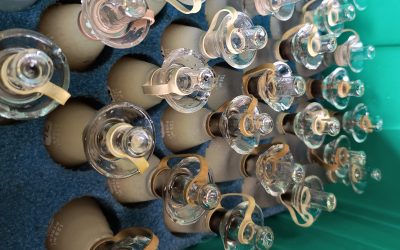2024 GO-SHIP A13.5
Decadal re-occupation of the U.S. GO-SHIP meridional hydrographic line known as A13.5 (0°E in the Atlantic Ocean)
The U.S. Global Ocean Ship-based Hydrographic Investigations Program (GO-SHIP) is part of the international GO-SHIP program, which carries out a systematic and global re-occupation of select hydrographic sections. A13.5 is in the southeastern Atlantic Ocean and was previously occupied in 1984, 1995, and 2010. Attempts in 2020 and 2022 were abandoned due to the pandemic.
Scientists from NOAA and academic institutions will collect full water column CTD rosette casts along the A13.5 section at 30 nautical mile (54km) spacing, with closer spacing at the basin boundaries. Measurements taken from the instrument package include temperature, salinity, oxygen, currents (LADCP), and particles (transmissometer). Discrete samples will be collected on these casts and analyzed for a variety of parameters including salinity, dissolved oxygen, nutrients, chlorofluorocarbons (CFCs), SF6 , dissolved inorganic carbon (DIC), alkalinity, pCO2 , pH, and dissolved organic carbon (DOC). Underway data collection will include upper-ocean current measurements from the shipboard ADCP, surface oceanographic (temperature, salinity, and CO2 ) and measurements from the ship’s scientific seawater supply, meteorological parameters, bathymetric data and atmospheric measurements of CO2 , CFCs, and SF6.
Deployments:
-
- 11 GO-BGC Navis floats from WHOI that measure biogeochemical properties like chlorophyll, nitrate, and oxygen in addition to temperature and salinity
- 7 EM Apex floats from UW APL that measure, temperature, salinity, velocity, ocean turbulence, and diffusivity
- 4 core Argo floats
- 1 deep Argo float
- 18 surface drifters
The following are the main overlapping scientific objectives:
- Data for Model Calibration and Validation
- Carbon System Studies
- Heat and Freshwater Storage and Flux Studies
- Deep and Shallow Water Mass and Ventilation Studies
- Calibration of Autonomous Sensors.
Please join along on the journey by following the expedition blog!
Chief Scientist: Zach Erickson (NOAA PMEL)
Co-Chief Scientist: Jesse Anderson (Earth and Space Research ESR)
Ship: Marcus G Langseth (Lamont-Doherty research vessel)
Departs: Mindelo, Cape Verde on February 1, 2024
Arrives: Cape Town, South Africa on March 23, 2024
2024 GO-SHIP A13.5 South Atlantic Expedition Logs
Navigating the ice
Ship Encounters with IcebergsDATE: 3/22/2024 As the R/V Marcus G. Langseth sailed toward 48 degrees South on March 14th, 2024, we were unexpectedly greeted by a trio of small icebergs, barely visible through the morning fog. A crew member remarked on the rarity of...
Ocean Depths
Exploring Extreme Pressure Changes How does water depth affect pressure changes? Simply put, as depth increases, the weight of the water above exerts more pressure on objects below, potentially causing them to shrink or collapse under the immense weight. This...
The Wonderful World of Alchemical Oxygen
Modifications to Classic Water Chemistry 11 March 2024 Alchemy is essentially the art of turning one substance into another purer form, or finding the deeper, true value of it through some magical route. Often it is thought of as being done by sorcerers, visionaries,...
Changes in Latitude
Invisible lines in the sea1 March 2024 When I was younger, I imagined the equator was a real line, if I went there, I’d be able to see it. As I got older, I learned it wasn’t like the globe, there is no bright red, yellow, or white line pointing out 0 degrees...
The R/V Marcus G. Langseth Team
From Bridge to EngineThe crew of the R/V Marcus G. Langseth (some of whom are pictured above) are experienced and dedicated sea-going professionals bound by the goal of facilitating scientific knowledge and ocean exploration. Whether it's investigating seismic...
POV: You are sampling the CTD
March 12, 2024Sampling the CTD is part of life for most scientists aboard research trips like this. Anywhere from 1-3 times a day when the CTD is pulled back on board we all come out of our labs where we had been hunkered down and gather to begin the dance at the...
Microplastic Microcosm
March 11, 2024It’s no secret that plastics and microplastics (MP) have spread like an unstoppable wave across our oceans. Marine plastics can be found covering the ocean’s surface and hiding in its deepest trenches. Their interactions with the larger species found in...
Ocean Carbon Chemistry
A glimpse into the hows and whys of ocean carbon chemistry aboard R/V Marcus G. Langseth and beyond 25 February 2024 Welcome Aboard! My name is Evan Josza and I am one of two dissolved inorganic carbon (DIC) analysts on the GO-SHIP A13.5 cruise. I am both grateful and...
Say Hello to My Little Friend(s)
Signs of life from the abyssal zoneEvery now and then, chemical oceanographers are confronted with very real evidence that there is, in fact, life in their water samples. Often called “bugs” in laboratory settings, their presence is generally ignored when gathering...
GO-BGC Floats – Part 2
What do the data tell us?13 March 2024 An earlier blog in our series described the Global Ocean Biogeochemistry Array (GO-BGC) program and their Adopt-a-Float outreach program. We showcased the first six of the 11 GO-BGC Navis Argo floats from Woods Hole...
Happy International Women’s Day
March 8, 20248 March 2024 The women on board R/V Marcus G. Langseth met in front of the main research deck where the CTD (Conductivity, Temperature, and Depth) rosette is located between a shift break to celebrate International Women’s Day! This global celebration,...
Atlantic Squid
From Sea to Canvas to Plate!25 February 2024 Have you ever seen a squid up close? Atlantic squid are abundant along the eastern coast of North America, Europe, and Africa. They are characterized by their streamlined, torpedo-shaped bodies and elongated tentacles,...












